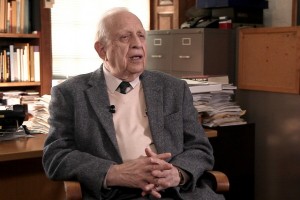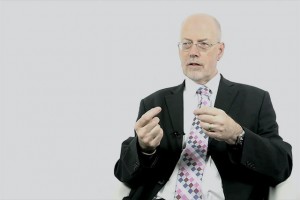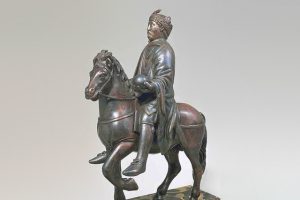Scientific Work in Los Alamos Program
Nobel Prize laureate Roy Glauber on avoiding predetonation, the Trinity test, and the hydrogen bomb

Quakers are members of the Religious Society of Friends, which in many cases calls itself the Friends Church. “Quaker” was originally an insulting nickname given to Friends in the 1650s, based on a widespread belief in England, where Quakerism began, that in their worship, when under the influence of the Holy Spirit (or perhaps evil spirits, depending on one‘s point of view), Friends would shake and quake. “Friends” is based on John 15:14, 15: “You are my friends if you do what I command you. No longer do I call you servants, for a servant does not understand what his master is doing. But I have called you friends because everything I have learned from My Father I have made known to you.”
Quakerism arose in England in the 1640s and 1650s. This was a time of civil war and political and social upheaval in England when the old established Church of England had lost its legal position, and many new religious groups were springing up. The first generation of Quakers often described themselves as “Seekers,” people who had not found the answers to their religious yearnings and desires in any of the churches and religious movements that then existed.
After Fox, the most prominent early Quaker leader was a Yorkshireman, James Nayler (1616/18-1660). One of the distinctive features of Quakerism was its belief in the spiritual equality of women that women had just as much right to preach and speak publicly as men. Thus a number of Quaker women were leaders. The most prominent was Margaret (Askew) Fell (1614-1702). Her home in Lancashire, Swarthmoor Hall, functioned as the headquarters of the Quaker movement in the 1650s.
Among the second generation of Quaker leaders after 1660, when the movement was consolidating and setting up organizational structures, the most prominent were William Penn (1644-1718) and Robert Barclay (1648-1690). Both came from aristocratic backgrounds and were better educated than most Friends. Penn used his connections with the Crown to obtain the charter for the colony of Pennsylvania in 1681. Barclay’s book, An Apology for the True Christian Divinity, is widely considered the most important single Quaker theological work.
When the Quaker movement began, it set itself off from other Christian groups in several important ways. The first was direct, continuing revelation. Quakers argued that revelation between God and humanity did not cease when the last book of the Bible was written but was still taking place and that all humans could have such experiences. Another distinction was the idea of the Inward Light. Friends believed that all people have within them a certain Divine Light, the Light of Christ Within. If they are obedient to it, it leads them to a good life and, ultimately, salvation. If they disobey it, they will come to spiritual death.

The third was the ministry of all believers. One of George Fox’s early “openings” was that “being trained up at Oxford or Cambridge did not make a minister of Jesus Christ.” Ministry came through inspiration from the Holy Spirit and was not the fruit of education. And, as noted above, women, as well as men, could be ministers. This brings us to the last idea that sets Quakers apart – equality. Friends believed that all people were equal in the sight of God. Thus they refused to make use of courtesy titles like “Mr.”, “Your Honor”, or “My Lady.” Instead, they addressed people by their names or as “Friends.” The Quaker practice of using “thee” and “thy” to everyone also grew out of this.
As noted above, Quakerism began in England in the 1640s and 1650s. Friends faced fierce persecution, at first because of accusations of blasphemy, then, after the Restoration of the monarchy in 1660, for refusal to worship in the established church. Thousands were fined or imprisoned until the Act of Toleration in 1689 ended such persecution. Friends in Ireland and Scotland faced similar problems.
After 1750, Quakers, both in the British Isles and in America, became increasingly identified with humanitarianism, philanthropy, and reform. Friends were at the center of the American and British antislavery movements. They were the first religious group to forbid members from holding slaves. Friends were also active in prison reform movements; English Quaker minister Elizabeth Fry was probably the best-known prison reformer in the world from 1820 until her death in 1845. Friends were also strong exponents of women’s rights. The first women’s rights convention in American history, at Seneca Falls, New York, in 1848, was organized largely by Quakers. Of the three main leaders of the American women’s rights movement before 1880, two, Lucretia Coffin Mott and Susan B. Anthony, were Friends.
In the nineteenth century, Quakers experienced a series of schisms and separations that laid the roots of contemporary Quaker diversity. A minority in North America, and eventually the majority in the British Isles, came to identify as theological liberals. In North America, they make up what is now the Friends General Conference. A majority of American Friends were more evangelical in orientation. After 1870, they moved closer to other Protestant groups and adopted a pastoral system of ministry. They were also responsible for most Quaker missionary work in other parts of the world. A few remained uncompromising primitivists and became known as Conservative Friends.
It is important to keep in mind that Quakers today are extremely diverse. They span the spectrum of American religious diversity. Some are fundamentalist Protestants who admire non-Quaker television evangelists like Pat Robertson and Jerry Falwell and ally themselves with groups like the Christian Coalition. Others are universalists who argue that Quakerism is not necessarily Christian or even theistic. Thus one can encounter self-described “Jewish atheist Quakers.” Most Quakers, however, think of themselves as Christians. This diversity makes Quakerism difficult to generalize. However, in the broadest terms, Friends of all persuasions would usually affirm the following:
1. Worship in the Spirit. Friends tend to be suspicious of ritualistic religion, believing that true worship is always open to the leading of the Spirit. That explains why some Friends follow Quaker tradition and gather for worship in silence, confident that if God has a message for the assembled group, God will inspire someone to speak. A majority of the world’s Friends now follow pastoral worship: one person is appointed to lead worship, and there are hymns sung and vocal prayer. But, again, emphasis is placed on providing openings for anyone who feels led to minister. This aversion to ritualism also explains why almost all Friends do not practice outward sacraments. Thus they do not make use of water baptism or physical communion with bread and wine. True sacraments, Friends have traditionally argued, are inward and spiritual, not outward and material.
2. Simplicity. Early Friends felt led to repudiate anything that built up human vanity. Thus they dressed plainly, eschewing the ruffles, laces, etc., that marked upper-class dress in seventeenth-century England. By the nineteenth century, this had become a kind of Quaker uniform, “plain dress.” This reinforced the Quaker sense of separateness from the larger world, the idea that Friends were called to be “a peculiar people.” Only a few Friends still hold to this. But Friends still see simplicity as a fundamental Quaker value. They define it in varied ways. For some, it means being unpretentious. Others see it in eschewing consumerism or in limiting one’s material possessions. Still, others see in it limiting commitments in order to be open to unexpected leadings or calls from God.

3. Sense of the meeting. This refers to the Quaker process of decision-making. When deciding matters of business, Quakers do not vote. The presiding officer is called a clerk, and his or her responsibility is to discern the will of God as manifested in the discussions of the group. The clerk tests his or her sense by proposing a minute, stating the decision to be made. If it accurately reflects the will of the group, they approve it. But if some Friends dissent, even a small group, the discussion continues. This refusal to vote is based on the conviction that the will of God is not necessarily the will of a human majority.
4. Integrity. Friends from the beginning saw themselves as called to high standards of truth speaking and honesty. Thus, for example, Quaker merchants refused to bargain over prices, believing that they had the right to ask only for what was just and fair. Friends made a point of paying debts. Declaring bankruptcy usually meant forfeiting membership. Friends have usually felt called to candor, even when it might be politically or socially awkward. Friends were among the first groups to use the phrase “speak truth to power.”
5. Peace. Historically, Friends have been associated with pacifism, the belief that deadly force, whether in self-defense or in the best of causes, is always wrong. A Supreme Court justice once observed that Quakers take the Sermon on the Mount literally. Historically, for a Quaker to take up arms was to forfeit membership. Today, such decisions are seen as a matter of individual conscience. But many Friends remain pacifists and are active in peace movements and groups. Quaker organizations like the American Friends Service Committee and the Friends Service Council see peacemaking as central to their missions.
The greatest change among Quakers has been the growing diversity of Friends. Quaker theology now spans the spectrum of Christian belief and beyond. As noted above, most Friends have given up the old ways of being silent, waiting for worship (although a significant minority still uses it), and adopted a pastoral, programmed method of worship not that different from other Protestant denominations.
Friends have experienced debates on sexual matters similar to those in other denominations. Some Friends hold extremely traditional views on sexual morality, viewing any sexual expression outside of heterosexual marriage as contrary to the will of God. Others have defined themselves as “welcoming and affirming” and endorse same-sex marriage.
Estimates of the number of Friends in the world today vary, but there is agreement that it is in the neighborhood of 350,000-400,000. Of these, about 90,000 are in the U.S.A. and Canada. About 20,000 are in Europe, and about 1,600 are in Australia and New Zealand. About 10,000 are in East Asia, about 57,000 in Latin America, and about 200,000 in Africa, nearly all in East Africa.
The Quakers’ presence in North America and the British Isles reflects historic residence patterns. Small Quaker groups, attracted by liberal theology, developed in the twentieth century in Europe, Australia, and New Zealand. Quakerism in Latin America, Asia, and Africa owes its existence to missionary work, mainly by American Friends, that began in the 1860s and has continued to the present.
Edited by Alina Shubina

Nobel Prize laureate Roy Glauber on avoiding predetonation, the Trinity test, and the hydrogen bomb

Economist Mark Harrison on self-interest, organized suicide acts, and the desire to belong

Historian Alexander Sidorov on the unique artifact of the Carolingian Renaissance — a mysterious statuette of ...